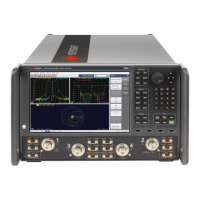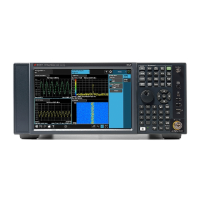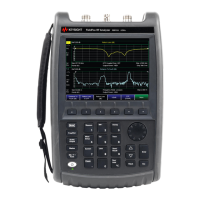8-8 Keysight N5221A/22A Service Guide
General Purpose Maintenance Procedures
Error Terms
8-
Error Term Data
The error term descriptions in this section include the following information:
— a table of the error terms
— description and significance of each error term
— measurements affected by each error term
— typical cause of failure for each error term
The same description applies to both the forward (F) and reverse (R) terms.
If Error Terms Seem Worse than Expected
To verify that the system still conforms to specifications, perform a system
verification. Refer to Chapter 3, “Tests and Adjustments.”.
Data are listed here as a convenience only. Detailed instrument
specifications are listed in the embedded help in the network analyzer.
Table 8-1 Error Term Data
a
Parameter
(All
options,
all ports)
Frequency Range
10 MHz
to
50 MHz
50 MHz
to
3.2 GHz
3.2 GHz
to
10 GHz
10 GHz
to
16 GHz
16 GHz
to
24 GHz
24 GHz
to
26.5 GHz
Directivity 16 dBm 24 dBm 23 dBm 16 dBm 16 dBm 16 dBm
Source
Match
11 dBm 18 dBm 14 dBm 12 dBm 10 dBm 8 dBm
Load Match 11 dBm 17 dBm 13 dBm 10 dBm 9 dBm 8 dBm
10 MHz
to
50 MHz
50 MHz
to
100 MHz
100 MHz
to
500 MHz
500 MHz
to
3.2 GHz
3.2 GHz
to
20 GHz
20 GHz
to
26.5 GHz
Crosstalk
b
-84 dBm -90 dBm -110 dBm -120 dBm -122 dBm -117 dBm
a. The data in this table are uncorrected system performance. The values apply over an environmental temperature range of 25
°C ±5 °C, with less than 1 °C deviation from the calibration temperature.
b. All crosstalk values are typical. Measurement conditions: normalized to a thru, measured with two shorts, 10 Hz IF band-
width, averaging factor of 8, alternate mode, source power set to the lesser of the maximum power out or the maximum
receiver power.

